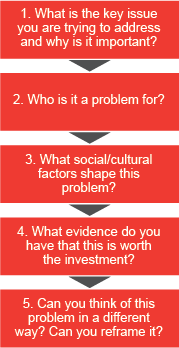2 Steps in problem definition
The quote attributed to Einstein is meant to get us to think before we act, and to think deeply. But how often do we do this? How frequently does the need to be seen to bring about results drive us to compromise on what we know is best practice?
Activity 2
We are all busy people, often working to tight deadlines. In order to engage effectively with the Problem Definition Tool, you will need to acknowledge some of your current practices. Read the following statements and think about how familiar they are to you. Have you said them out loud to others or silently to yourself, or heard similar from others around you?
- The sooner the project starts, the sooner it will be finished.
- A rough understanding of the problem will do because we can work out the detail as we go along.
- We have to see the problem clearly, which means keeping it tightly controlled.
- There’s no point unpacking the problem because it will change.
- The more we unpack the problem, the more we won’t be able to solve it.
- If we look too deeply we won’t just have one problem, but many problems.
- Defining the problem too closely can bring competing factions out fighting.
- We have the resource for fixing this problem, so let’s set about fixing it.
- Some things are better left unknown/unsaid.
Discussion
It is very likely that at least some of these statements were familiar to you. We are often in a hurry to get things done, and can easily fall into time-pressured decisions. The Problem Definition Tool helps us to spend time on really understanding an issue before we leap into trying to solve it.
The flow chart in Figure 2 below shows the questions you need to ask to systematically define the problem, which we will now look at in detail.

1 When to conduct a detailed problem definition
